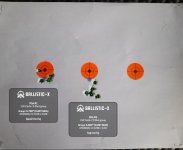This isn't a topic I've really seen addressed here but there has been quite a bit of discussion on it for a while stateside. Simply put, most carbines will show a shift of POI when transitioning from prone with a bipod/rear bag to shooting off bags or supported positional (barricade and/or tripod) shooting. This applies to carbines with "free float" handguards as well as non-free float designs. All of the talk around this down south is to do with ARs (obviously) and how best to mitigate it, monolithic or semi monolithic uppers being the best answer but you can make good improvements with larger barrel nuts and stiffer handguards. Even though we can't legally shoot our AR pattern rifle any more, this still all applies to Ravens, Cryptos, Canadian AR-180s, Tavors, etc. I'm curious how many guys check for this kind of POI shift? It's only something that comes into effect if you're shooting your carbine the way you'd shoot a precision rifle (ie bipod and rear bag) and also shooting supported positional or tripod, for run 'n gun setups it's not really a factor. It's something I have the guys in my scoped carbine classes test for as it's a piece of data that is very important to have so you can decide how to deal with it.
As a general rule, all (AR and AR180 pattern) carbines tend to exhibit a POI shift down when zeroed prone but shot off bags or a tripod/positional. The 2 methods for dealing with this, once you've figured what the shift is, are to either zero between the 2 different POIs or to zero prone but understand how much elevation to add when shooting supported positional. The first method works very well with systems that exhibit minimal POI shift (say 0.2mrad) as long as you engage targets that are say 0.3 mrad tall. The =/- 0.1 mrad gets lost in the height of the target. For rifles that exhibit more shift than that, I prefer to zero prone and add the offset to my dope when shooting supported positional, so if your offset is 0.4 mrad down and my dope for 300yds is 1.1 mrad but I'm shooting off a support bag, I'd dial/hold 1.5 mils.
I'd be curious to hear others thoughts on this topic and/or see what you get as you test for this offset.
The pics below are from some targets shot with a BCL Siberian:
The first pic is 5x 10rnd groups shot at 100yds.
Top left target is checking zero (which was off) with bipod towards end of handguard.
Top right is checking zero after making the adjustment from T1.
Bottom right is after moving the bipod all the way back to the mag well.
Middle target is shooting off a bag at the mag well.
Bottom left target is checking zero a final time with bipod towards end of handguard.
As you can see, the offset down from shooting off bags at the mag well is aprox 0.2 mrad while the offset down from shooting with the bipod all the way back is just about 0.4 mrad.

The 2nd pic is 2x 10rnd groups shot at 100yds.
The left target is shot seated off a bipod (and wasn't my finest shooting, haha)
The right target was shot after to verify zero (prone with bipod out front and rear bag)
As you can see, the offset is approx 0.2 mrad

As a general rule, all (AR and AR180 pattern) carbines tend to exhibit a POI shift down when zeroed prone but shot off bags or a tripod/positional. The 2 methods for dealing with this, once you've figured what the shift is, are to either zero between the 2 different POIs or to zero prone but understand how much elevation to add when shooting supported positional. The first method works very well with systems that exhibit minimal POI shift (say 0.2mrad) as long as you engage targets that are say 0.3 mrad tall. The =/- 0.1 mrad gets lost in the height of the target. For rifles that exhibit more shift than that, I prefer to zero prone and add the offset to my dope when shooting supported positional, so if your offset is 0.4 mrad down and my dope for 300yds is 1.1 mrad but I'm shooting off a support bag, I'd dial/hold 1.5 mils.
I'd be curious to hear others thoughts on this topic and/or see what you get as you test for this offset.
The pics below are from some targets shot with a BCL Siberian:
The first pic is 5x 10rnd groups shot at 100yds.
Top left target is checking zero (which was off) with bipod towards end of handguard.
Top right is checking zero after making the adjustment from T1.
Bottom right is after moving the bipod all the way back to the mag well.
Middle target is shooting off a bag at the mag well.
Bottom left target is checking zero a final time with bipod towards end of handguard.
As you can see, the offset down from shooting off bags at the mag well is aprox 0.2 mrad while the offset down from shooting with the bipod all the way back is just about 0.4 mrad.

The 2nd pic is 2x 10rnd groups shot at 100yds.
The left target is shot seated off a bipod (and wasn't my finest shooting, haha)
The right target was shot after to verify zero (prone with bipod out front and rear bag)
As you can see, the offset is approx 0.2 mrad

Last edited:







































































